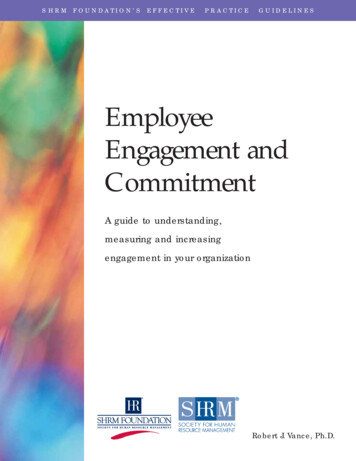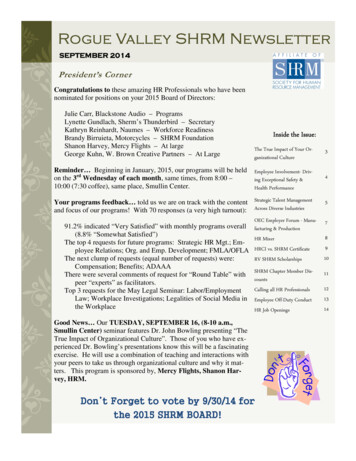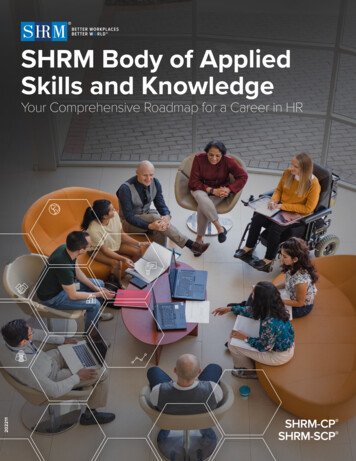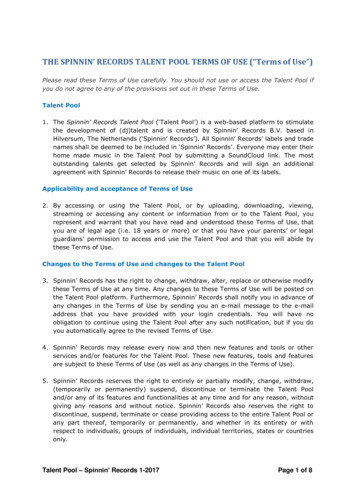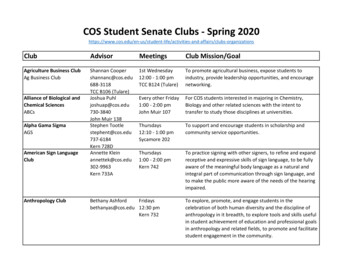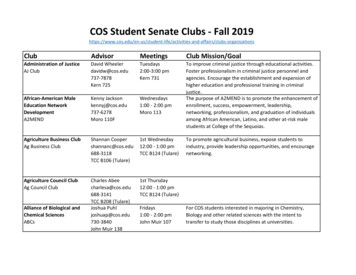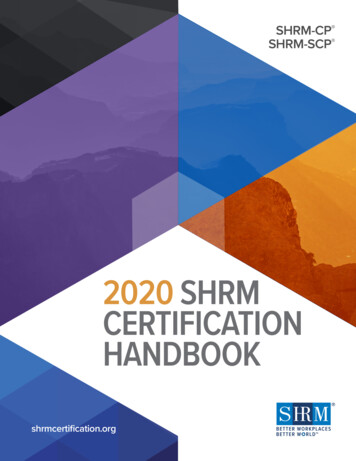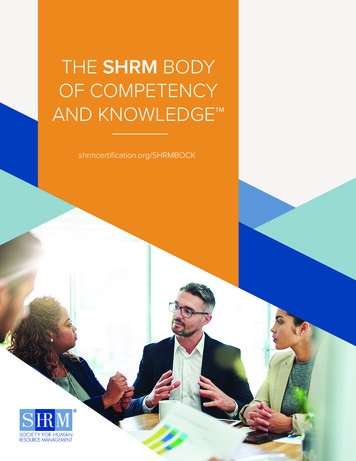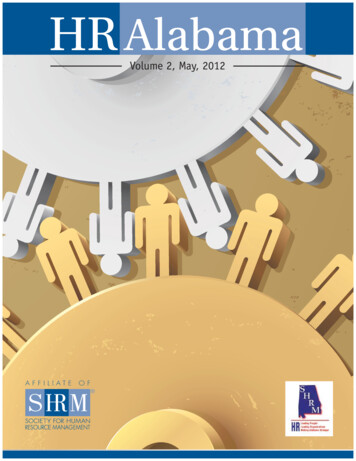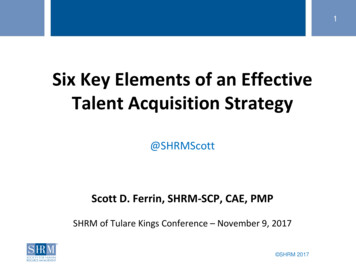
Transcription
1Six Key Elements of an EffectiveTalent Acquisition Strategy@SHRMScottScott D. Ferrin, SHRM-SCP, CAE, PMPSHRM of Tulare Kings Conference – November 9, 2017 SHRM 2017
2Definition of Talent AcquisitionTalent Acquisition is the process ofattracting and recruiting the best talentavailable to ensure your organization hasthe right people, with the right skills,who are in the right job, and areworking against the right requirements.Source: SHRM Body of Competency and Knowledge (BOCK) SHRM 2017
3Definition of Talent AcquisitionPerspective Videohttps://www.youtube.com/watch?v RVssSA0p6f4 SHRM 2017
Importance of Talent Acquisition4Winning in today’s competitivebusiness world is largely dependenton having the right people toimplement the organization’s businessstrategyCompanies that implement effectivetalent acquisition strategies usuallyend up winning, while bad hires cancut deeply into company profits SHRM 2017
Six Key Elements of an EffectiveTalent Acquisition Strategy1) Conduct workforce planning2) Build your employer brand3) Source and recruit job candidates4) Leverage recruiting technology5) Develop an effective onboarding program6) Utilize data analytics SHRM 20175
1) Conduct Workforce PlanningWorkforce planning is a basicstep in developing an effectivetalent acquisition strategyWP is the process anorganization uses to analyze itsworkforce and determine thesteps it must take to prepare forfuture staffing needs SHRM 20176
1) Conduct Workforce PlanningThe Workforce Planning ProcessThere is no standard WP model that can beused across all companiesEvery strategic staffing decision should beconsistent with and linked to yourorganizational mission and goalsWP must be integrated with your strategicbusiness planning and budgetary processes SHRM 20177
1) Conduct Workforce PlanningKey Workforce Planning Steps1– Supply Analysis2 – Demand Analysis3 – Gap Analysis4 – Solution AnalysisSource: “Practicing the Disciple of Workforce Planning,”SHRM Toolkit SHRM 20178
1) Conduct Workforce Planning9Workaday-HCI survey of 400 US professionalsWP is recognized as an essential priority,but it is difficult to implement effectively69% considered WP essential, but only 44%are actively engaged with it45% reported that their organization isunprepared to meet future talent needs40% said that business leaders do notadequately promote WP SHRM 2017
2) Build Your Employer BrandWhy is Your Employer Brand Important?2015 LinkedIn research: 62% percent ofprofessionals across 26 countries rankedemployer brand as the deciding factor whenapplying for a jobJob candidates today research employerscarefully and expect to be engaged by them ina relevant and transparent mannerYour employer brand needs to convey thatyour culture, benefits and growth opportunitiesare superior to those of your competitors SHRM 201710
2) Build Your Employer Brand11Key Components of Your Branding Strategy Discover your unique identity/brand Design your online and other contentaround this identity Create a fan base of employees Check out the competition Measure and track key performanceindicatorsSource: Pamela Babcock, “Keeping it Real: Getting EmployerBranding Right, Oct. 15, 2015 SHRM 2017
2) Build Your Employer Brand12Careers Page Branding for Job CandidatesMake the most of your Careers site:Reveal your brand identitySell your companyUse creative mediaFocus on the potential applicant SHRM 2017
2) Build Your Employer BrandThe Power of Your Careers Page – Adobe SHRM 201713
2) Build Your Employer Brand14Leverage Social Media to Build your BrandEmployer Branding International 18-countrysurvey: The top channel (76%) used bycompanies for employer branding was socialmediaTop North American brand initiatives are:--Social Media 58%--Career Site Development 56%--Recruitment Advertising/Marketing 52% SHRM 2017
3) Recruiting Job CandidatesRecruiting internally vs. externallyInternal sourcing has cost andother advantages overexternal sourcingAverage cost to replace anemployee is at least 150% ofthe employee’s base salary,according to the Bliss-Gately“Cost-to-Replace Tool” SHRM 201715
3) Recruiting Job CandidatesSuccession Planning & Internal SourcingSuccession Planning facilitates internalsourcing by identifying and preparing suitableemployees to fill key positions when currentemployees leaveThe Succession Planning process includes areview of key leadership and business-criticalroles and identifies incumbents to move intothese roles2015 XpertHR survey: 40% of organizations donot have a formal succession planning process inplace SHRM 201716
3) Recruiting Job CandidatesCareer and leadership development programs can provideenriching opportunities to improve skills and knowledge SHRM 201717
3) Recruiting Job CandidatesThree Types of External Job SeekersActive job seekers: Actively looking forinformation about job openingsSemi-passive job seekers: Interested in anew position but only occasionally lookactively for onePassive job seekers: Currently employedand not actively seeking another job, butcould be tempted by the right opportunity SHRM 201718
3) Recruiting Job CandidatesCommon Methods of External RecruitingEmployee referralsOrganization’sCareers Web pageJob postingsOnline recruitingMedia advertisingSearch firmsWeb crawlersJob boardsSocialmediaNetworkingsitesIntern programsCollegerecruitingJob fairsRaidingCompetitorsInternet miningBooleansearchesFormer employees SHRM 201719
3) Recruiting Job CandidatesExternal Recruiting: Attracting & SourcingAttracting candidates: Company Careers pageEmployee referralsJobs postingsSocial media advertisingTraditional media advertisingSourcing/targeting candidates: Social media searchesInternet mining/Boolean searchesAlgorithmsJob boardsResume databasesNetworking sites SHRM 201720
3) Recruiting Job Candidates21Employee referrals a top source for best candidatesJobvite 2015 survey of 1,400 US recruiters78% list referrals as most effective source fortargeting and hiring high-quality candidatesOther effective sources include social networks(56%), intern programs (55%), direct applications(46%), and external recruiters (38%)Traditional online job boards are down from 57%in 2009 to 37% in 2015 SHRM 2017
4) Leverage Recruiting TechnologyMobile recruiting is growingSHRM 2015 Survey on Use of Social Media forTalent Acquisition66% of organizations have taken steps toleverage mobile recruiting to target smartphoneusersMost common mobile recruiting stepsorganizations have taken are:1) Optimizing their careers websites (39%)2) Optimizing Job postings (36%)3) Optimizing application processes for mobileusers (36%) SHRM 201722
4) Leverage Recruiting Technology23Why is mobile recruiting important?Kelton Global-Jibe 2014 survey:86% of active candidates use their smartphonesto begin a job search70% of active candidates want to apply via mobile20% of the respondents would be deterred fromcompleting an application if they couldn’tcomplete it on their mobile devices25% of larger companies said no part of theirhiring process had been mobile-optimized SHRM 2017
4) Leverage Recruiting Technology24Be careful screening candidates via social mediaSHRM 2015 Survey on“Use of Social Media for Talent Acquisition”43% of HR professionals said they use public socialmedia or online searches to screen job candidates,up from 33% in 201336% of employers in 2015 rejected a job candidatebecause of information found on public socialmedia sites or online searchesThe most common reasons for not using socialmedia to screen job candidates are legal risks,relevancy and accuracy of information, and privacyconcerns SHRM 2017
4) Leverage Recruiting Technology25Algorithms can ease the recruiter’s jobComputer algorithms can take massiveamounts of data generated before, during andafter the recruiting process and turn it intoactionable informationThe goal is to predict whether a person will beright for the job, the team and the companyHarvard Business Review analysis of 17studies of applicant evaluations: A simplealgorithm outperformed human decisionsby 25% SHRM 2017
4) Leverage Recruiting Technology26Talent Mining/Boolean SearchesTalent mining is the science of sorting throughlarge amounts of human capital data on theinternet and multiple sites.Talent mining is commonly performedautomatically through Boolean search stringsto retrieve data that a recruiter can use fortalent identification/acquisition.A Boolean search allows users to combinekeywords such as AND, NOT, and OR toproduce more relevant results.Boolean searching is evolving and holds greatpromise for easing the recruiter’s job. SHRM 2017
5) Effective Onboarding Program27Onboarding is a key to retentionOnboarding is a systematic andcomprehensive program to integrate a newemployee within a company and its cultureIt gives the new employee the tools andinformation to become a productive member ofthe teamOnboarding should be a strategic process thatlasts at least one year to ensure high retention SHRM 2017
5) Effective Onboarding Program28Effective onboarding brings big benefitsAberdeen Group study:86% of respondents felt that a new hire’sdecision to stay with a company long-term ismade within the first six months of employment66% of companies with onboarding programsclaimed a higher rate of successfulassimilation of new hires into company culture62% percent had higher time-to-productivityratios, and 54% percent reported higheremployee engagement SHRM 2017
5) Effective Onboarding Program29Start Early and Assign a MentorAberdeen survey: 83% of highestperforming organizations began onboardingprior to the new hire’s first day on the job.Also, high-performing organizations are 2.5times more likely than lower-performingemployers to assign a mentor during theonboarding process.The end of the first year is when traditionalonboarding transitions from on-the-jobtraining to continuous development. SHRM 2017
6) Utilize Data Analytics30“Data analytics can improve the effectiveness ofa company’s talent acquisition function, determinejob competencies for each role and measurecandidates’ potential performance before makinga job offer.Ultimately, recruiting and hiring data can becorrelated with business outcomes, such asincreased revenue, which positions talentacquisition as a strategic function in the business.”Ji-A MinHead Data scientistIdeal Candidate SHRM 2017
6) Utilize Data Analytics31Deloitte 2015 Talent Analytics report:75% of HR executives say that usinganalytics is an important driver oforganizational successYet, 51% have no formal talent analyticsplan in placeClose to 40% say they don’t have theresources to perform analytics, and 56%rate their own skills in workforce analyticsas poor SHRM 2017
6) Utilize Data Analytics32LinkedIn Global Recruiting Trends 2016Quality of hireTop metric (39%) organizations use tomeasure their recruiting performanceTime-to-fillSecond most important metric (28%) forperformance measurementTop sources of quality hires Social professional networks (43%) Online job boards (42%) Employee referrals (32%) SHRM 2017
6) Utilize Data Analytics33The Holy Grail: How to measure quality of hire?Figuring out how to define the criticalQuality-of-Hire measurement is a majorchallenge for most organizationsThere is no one-size-fits-all metric forQuality-of-Hire because it depends onyour business prioritiesCommon Quality-of-Hire metrics includeturnover rates, job performance, employeeengagement and cultural fit SHRM 2017
Effective Results34Example VideoZappos!https://www.youtube.com/watch?v 9C36EYM-mWQ SHRM 2017
SHRM-SHRM Foundation Support Resources35SHRM Talent Acquisition NewsletterSHRM Seminar both Virtual and Live,“Creating a Talent Acquisition Strategy”SHRM website: Talent Managementsection, SHRM LINE EmploymentReport and research surveys, Featurearticles, HR MagazineSHRM Foundation Executive PracticeGuidelines, Research Reports,Executive Briefings SHRM 2017
36 SHRM 2017
37THANK YOU! SHRM 2017
38Scott D. FerrinSHRM-SCP, PMPField Services Directorscott.ferrin@shrm.org(800) 283-7476 x6453@SHRMScott SHRM 2017
Sep 17, 2011 · articles, HR Magazine SHRM Foundation Executive Practice Guidelines, Research Reports, Executive Briefings SHRM 2017 36 SHRM 2017 37 THANK YOU! SHRM 2017 38 Scott D. Ferrin SHRM-SCP, PMP Field Services Director scott.ferrin@shrm.org (800)
